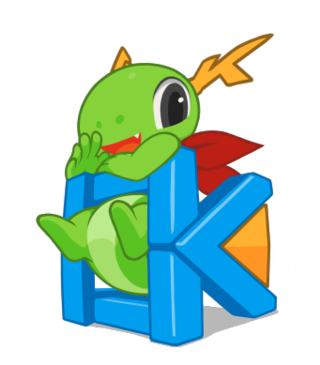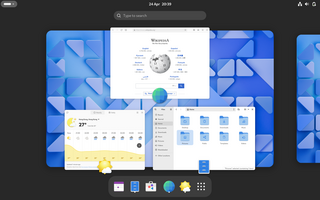Related Research Articles

Gnumeric is a spreadsheet program that is part of the GNOME Free Software Desktop Project. Gnumeric version 1.0 was released on 31 December 2001. Gnumeric is distributed as free software under the GNU General Public License; it is intended to replace proprietary spreadsheet programs like Microsoft Excel. Gnumeric was created and developed by Miguel de Icaza, but he has since moved on to other projects. The maintainer as of 2002 was Jody Goldberg.

Miguel de Icaza is a Mexican programmer, best known for starting the GNOME, Mono, and Xamarin projects.

OpenDoc is a defunct multi-platform software componentry framework standard created by Apple in the 1990s for compound documents, intended as an alternative to Microsoft's proprietary Object Linking and Embedding (OLE). It is one of Apple's earliest experiments with open standards and collaborative development methods with other companies. OpenDoc development was transferred to the non-profit Component Integration Laboratories, Inc., owned by a growing team of major corporate backers and effectively starting an industry consortium. In 1992, the AIM alliance launched between Apple, IBM, and Motorola—with OpenDoc as a foundation. With the return of Steve Jobs to Apple, OpenDoc was discontinued in March 1997.
In computing, a compound document is a document that “combines multiple document formats, either by reference, by inclusion, or both.” Compound documents are often produced using word processing software, and may include text and non-text elements such as barcodes, spreadsheets, pictures, digital videos, digital audio, and other multimedia features.

Calligra Sheets is a free software spreadsheet application that is part of Calligra Suite, an integrated graphic art and office suite developed by KDE.

GLib is a bundle of three low-level system libraries written in C and developed mainly by GNOME. GLib's code was separated from GTK, so it can be used by software other than GNOME and has been developed in parallel ever since.
D-Bus is a message-oriented middleware mechanism that allows communication between multiple processes running concurrently on the same machine. D-Bus was developed as part of the freedesktop.org project, initiated by GNOME developer Havoc Pennington to standardize services provided by Linux desktop environments such as GNOME and KDE.

Assistive Technology Service Provider Interface (AT-SPI) is a platform-neutral framework for providing bi-directional communication between assistive technologies (AT) and applications. It is the de facto standard for providing accessibility to free and open desktops, like Linux or OpenBSD, led by the GNOME Project.
This is an overview of software support for the OpenDocument format, an open document file format for saving and exchanging editable office documents.

Component-based software engineering (CBSE), also called component-based development (CBD), is a style of software engineering that aims to build software out of loosely-coupled, modular components. It emphasizes the separation of concerns among different parts of a software system.
OpenFormula is an open standard for exchanging recalculated formulae in spreadsheets. OpenFormula is included in version 1.2 of the OpenDocument standard. OpenFormula was initially proposed and drafted by David A. Wheeler.
COM Structured Storage is a technology developed by Microsoft as part of its Windows operating system for storing hierarchical data within a single file. Strictly speaking, the term structured storage refers to a set of COM interfaces that a conforming implementation must provide, and not to a specific implementation, nor to a specific file format. In addition to providing a hierarchical structure for data, structured storage may also provide a limited form of transactional support for data access. Microsoft provides an implementation that supports transactions, as well as one that does not.

KDE Platform 4 was a collection of libraries and software frameworks by KDE that served as technological foundation for KDE Software Compilation 4 distributed under the GNU Lesser General Public License (LGPL). KDE Platform 4 was the successor to KDElibs and the predecessor of KDE Frameworks. KDE Platform 4 is the only version of KDE Platform, and in 2013 it was replaced by KDE Frameworks 5.
Component Object Model (COM) is a binary-interface standard for software components introduced by Microsoft in 1993. It is used to enable inter-process communication object creation in a large range of programming languages. COM is the basis for several other Microsoft technologies and frameworks, including OLE, OLE Automation, Browser Helper Object, ActiveX, COM+, DCOM, the Windows shell, DirectX, UMDF and Windows Runtime. The essence of COM is a language-neutral way of implementing objects that can be used in environments different from the one in which they were created, even across machine boundaries. For well-authored components, COM allows reuse of objects with no knowledge of their internal implementation, as it forces component implementers to provide well-defined interfaces that are separated from the implementation. The different allocation semantics of languages are accommodated by making objects responsible for their own creation and destruction through reference-counting. Type conversion casting between different interfaces of an object is achieved through the QueryInterface method. The preferred method of "inheritance" within COM is the creation of sub-objects to which method "calls" are delegated.

GNOME, originally an acronym for GNU Network Object Model Environment, is a free and open-source desktop environment for Linux and other Unix-like operating systems.
An Internet operating system, or Internet OS, is any type of operating system designed to run all of its applications and services through an Internet client, generally a web browser. The advantages of such an OS would be that it would run on a thin client, allowing cheaper, more easily manageable computer systems; it would require all applications to be designed on cross-platform, open standards; and would not tie a user's applications, documents, and preferences to a single computer, but rather place them in the Internet cloud. The Internet OS has also been promoted as the perfect type of platform for software as a service.

Mono is a free and open-source .NET Framework-compatible software framework. Originally by Ximian, it was later acquired by Novell, and is now being led by Xamarin, a subsidiary of Microsoft and the .NET Foundation. Mono can be run on many software systems.

MATE is a desktop environment composed of free and open-source software that runs on Linux, and other Unix-like operating systems such as BSD, and illumos operating systems.

GNOME 2 is the second major release of the GNOME desktop environment. Building upon the release of GNOME 1, development of GNOME 2 focused on a greater design-oriented approach that simplified and standardized elements of the environment. It also introduced modern font and image rendering, with improved accessibility and internationalization, and improved performance. It was released on June 26, 2002 at the Linux Symposium.
References
- ↑ GNOME Library Archived 2009-08-07 at the Wayback Machine , retrieved on August 31, 2007
- ↑ "Bonobo and CORBA". developer.gnome.org. Archived from the original on 2016-04-11. Retrieved 2017-11-04.
- ↑ GNOME 2.22 Release Notes